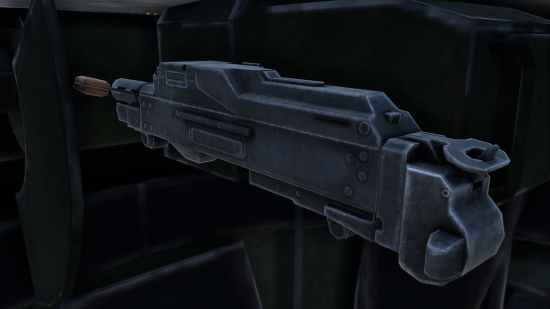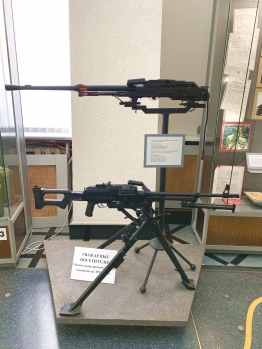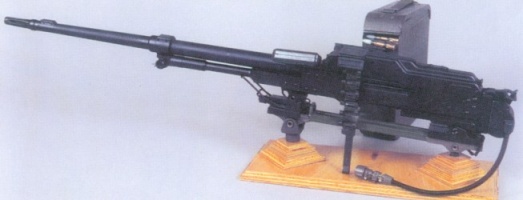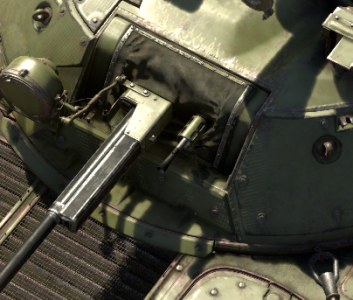Difference between revisions of "PKT (7.62 mm)"
(→Vehicles equipped with this weapon) |
m (→Vehicles equipped with this weapon) |
||
| (31 intermediate revisions by 8 users not shown) | |||
| Line 1: | Line 1: | ||
| + | [[File:PKT.png|550px|thumb|right|The PKT inside of the BMP-2M turret]] | ||
== Description == | == Description == | ||
<!-- ''Write an introduction to the article in 2-3 small paragraphs. Briefly tell us about the history of the development and combat using the weaponry and also about its features. Compile a list of air, ground, or naval vehicles that feature this weapon system in the game.'' --> | <!-- ''Write an introduction to the article in 2-3 small paragraphs. Briefly tell us about the history of the development and combat using the weaponry and also about its features. Compile a list of air, ground, or naval vehicles that feature this weapon system in the game.'' --> | ||
| − | + | The '''PK''' machine gun (Russian: Пулемёт Калашникова; ''Pulemyot Kalashnikova'', English: "Kalashnikov's machine gun") was designed as a replacement for the [[SGMT (7.62 mm)]] machine gun. It was designated as the '''PKT''' for use in tank coaxial mounts, and '''PKB''' for use on pintle mounts. A modernised variant known as the '''PKM''' was later developed, lightening and simplifying the system, along with corresponding '''PKMT''' and '''PKMB''' configurations. | |
| − | |||
| − | |||
=== Vehicles equipped with this weapon === | === Vehicles equipped with this weapon === | ||
<!-- ''List out vehicles that are equipped with the weapon.'' --> | <!-- ''List out vehicles that are equipped with the weapon.'' --> | ||
| − | {{Navigation-Start| | + | {{Navigation-Start|PKT}} |
| − | {{Navigation-First-Line|'''Light tanks'''}}{{Specs-Link| | + | {{Navigation-First-Line|'''Light tanks'''}}{{Specs-Link|ussr_pt_76_57}}{{-}}{{Specs-Link|sw_cv_9030_fin}} |
| + | {{Navigation-Line|BTR}}{{Specs-Link|ussr_btr_80a}}{{-}}{{Specs-Link|it_btr_80a_hungary}} | ||
| + | {{Navigation-Line|BMP/D}}{{Specs-Link|ussr_bmp_1}}{{-}}{{Specs-Link|germ_bmp_1_ddr}}{{-}}{{Specs-Link|ussr_bmp_2}}{{-}}{{Specs-Link|ussr_bmp_2m}}{{-}}{{Specs-Link|ussr_bmp_3}}{{-}}{{Specs-Link|ussr_bmd_4}}{{-}}{{Specs-Link|sw_pbv_501}} | ||
| + | {{Navigation-Line|2S25}}{{Specs-Link|ussr_2s25}}{{-}}{{Specs-Link|ussr_2s25m}} | ||
{{Navigation-Line|'''Medium tanks'''}} | {{Navigation-Line|'''Medium tanks'''}} | ||
| − | {{Navigation-Line|T-55}}{{Specs-Link|ussr_t_55_am}} | + | {{Navigation-Line|T-55}}{{Specs-Link|ussr_t_55_am}}{{-}}{{Specs-Link|ussr_t_55_amd_1}} |
{{Navigation-Line|T-62}}{{Specs-Link|ussr_t_62}}{{-}}{{Specs-Link|cn_t_62}}{{-}}{{Specs-Link|ussr_t_62m1}} | {{Navigation-Line|T-62}}{{Specs-Link|ussr_t_62}}{{-}}{{Specs-Link|cn_t_62}}{{-}}{{Specs-Link|ussr_t_62m1}} | ||
{{Navigation-Line|T-64}}{{Specs-Link|ussr_t_64a_1971}}{{-}}{{Specs-Link|ussr_t_64_b_1984}} | {{Navigation-Line|T-64}}{{Specs-Link|ussr_t_64a_1971}}{{-}}{{Specs-Link|ussr_t_64_b_1984}} | ||
| − | {{Navigation-Line|T-72}}{{Specs-Link|ussr_t_72a}}{{-}}{{Specs-Link|ussr_t_72av_turms}}{{-}}{{Specs-Link|ussr_t_72b}}{{-}}{{Specs-Link|ussr_t_72b_1989}}{{-}}{{Specs-Link|ussr_t_72b3_2011}} | + | {{Navigation-Line|T-72}}{{Specs-Link|ussr_t_72a}}{{-}}{{Specs-Link|ussr_t_72av_turms}}{{-}}{{Specs-Link|germ_kpz_t72m1}}{{-}}{{Specs-Link|it_t_72m1}}{{-}}{{Specs-Link|sw_t_72m1}}{{-}}{{Specs-Link|ussr_t_72m2_moderna}}{{-}}{{Specs-Link|ussr_t_72b}}{{-}}{{Specs-Link|ussr_t_72b_1989}}{{-}}{{Specs-Link|ussr_t_72b3_2011}} |
| − | {{Navigation-Line|T-80}}{{Specs-Link|ussr_t_80b}}{{-}}{{Specs-Link|ussr_t_80u}}{{-}}{{Specs-Link| | + | {{Navigation-Line|T-80}}{{Specs-Link|ussr_t_80b}}{{-}}{{Specs-Link|ussr_t_80bvm}}{{-}}{{Specs-Link|ussr_t_80u}}{{-}}{{Specs-Link|ussr_t_80ud}}{{-}}{{Specs-Link|sw_t_80u|▄T 80 U}}{{-}}{{Specs-Link|ussr_t_80uk}}{{-}}{{Specs-Link|ussr_t_80um2}}{{-}}{{Specs-Link|ussr_t_80ue1}} |
| − | {{Navigation-Line|T-90}}{{Specs-Link|ussr_t_90a}} | + | {{Navigation-Line|T-90}}{{Specs-Link|ussr_t_90a}}{{-}}{{Specs-Link|ussr_t_90m_2020}}{{-}}{{Specs-Link|uk_t_90s_bheeshma}} |
| + | {{Navigation-Line|'''Tank destroyers'''}}{{Specs-Link|ussr_2s3m}}{{-}}{{Specs-Link|ussr_object_775}} | ||
| + | |||
| + | {{Navigation-Line|'''SPAAs'''}}{{Specs-Link|ussr_btr_zd}} | ||
| + | |||
| + | {{Navigation-First-Line|'''Helicopters'''}}{{Specs-Link|mi_8amtsh}} | ||
| + | |||
| + | {{Navigation-End}} | ||
| + | |||
| + | {{Navigation-Start|PKTM}} | ||
| + | |||
| + | {{Navigation-First-Line|'''Light tanks'''}}{{Specs-Link|ussr_2s38}} | ||
| + | |||
| + | {{Navigation-End}} | ||
| + | |||
| + | {{Navigation-Start|PKMB}} | ||
| + | |||
| + | {{Navigation-First-Line|'''SPAAs'''}}{{Specs-Link|ussr_9a35_m2}} | ||
{{Navigation-End}} | {{Navigation-End}} | ||
| Line 48: | Line 67: | ||
[[File:Kalashnikov_Museum-13.jpg|x350px|thumb|right|A PKMT and PKMS on display.]] | [[File:Kalashnikov_Museum-13.jpg|x350px|thumb|right|A PKMT and PKMS on display.]] | ||
| − | The Soviets set out a requirement in the 1950s for a GPMG firing the standard 7.62x54mmR cartridge in belt-fed configuration, with the ability to be fired from an infantry bipod, a tripod, and from a vehicle mount.<ref name="Popenker_PK">Popenker "Kalashnikov PK / PKM"</ref> By 1956, a machine gun developed G.I. Nikitin, with co-designer Yuri M. Sokolov, became close to fulfilling the Soviet military's GPMG requirements. The weapon went far enough for a field service trial procurement in 1958. However, the General | + | The Soviets set out a requirement in the 1950s for a GPMG firing the standard 7.62x54mmR cartridge in belt-fed configuration, with the ability to be fired from an infantry bipod, a tripod, and from a vehicle mount.<ref name="Popenker_PK">Popenker "Kalashnikov PK / PKM"</ref> By 1956, a machine gun developed by G.I. Nikitin, with co-designer Yuri M. Sokolov, became close to fulfilling the Soviet military's GPMG requirements. The weapon went far enough for a field service trial procurement in 1958. However, the General Artillery Department of the Soviet Army, dissatisfied by the machine gun's slow development, decided to ask Mikhail Kalashnikov, the designer of the Kalashnikov assault rifle (also known as the AK), to build a GPMG to compete with Nikitin's design in a bid to accelerate their development time.<ref name="Popenker_PK"/><ref name="YT_PK2">Forgotten Weapons 2019, 6:55 - 8:43</ref> Kalashnikov agreed and set to work with a team in his bureau on a GPMG that was soon developed and competed against Nikitin's GPMG. The result was that Kalashnikov's weapon won out in the trials and his new GPMG became standardized for service in 1961 as the '''PK''', or the ''Pulemet Kalashnikova'' (''Kalashnikov's Machine Gun'').<ref name="HistoryNet_PK">Schuster 2016</ref> |
| − | The PK machine gun was a gas-operated, belt-fed machine gun that was air-cooled with a manual gas regulator and fired from an open-bolt. The PK machine gun was relatively lightweight at 9 | + | The PK machine gun was a gas-operated, belt-fed machine gun that was air-cooled with a manual gas regulator and fired from an open-bolt. The PK machine gun was relatively lightweight at 9 kg (~19.8 lbs) compared to other GPMGs of the era. The PK was able to feed 7.62x54mmR belts compatible with the [[Maxim's (7.62 mm)|Maxim]] and SG-43. However, the PK machine gun was only able to accept the belt feed from the right side only.<ref name="Popenker_PK"/> The PK machine gun as designed took elements from many other existing weapon systems. The PK's operating action and bolt design inside the PK was derived from the AK, with the action flipped upside down to allow the belt-feed. The PK's mechanism of stripping the cartridge from the belt, as well as the barrel change system, was from the SG-43. The PK's feed pawl was from the Czech Vz52, and its trigger mechanism was from the Degtyarev machine gun.<ref name="ForgottenWeapons_PK">McCollum 2012</ref><ref name="DIA_SmallArms">Kettrick 1983, p.235</ref> |
As a GPMG, the PK machine gun is available in four different configurations:<ref name="Popenker_PK"/> | As a GPMG, the PK machine gun is available in four different configurations:<ref name="Popenker_PK"/> | ||
| Line 56: | Line 75: | ||
* ''PKS'': Medium machine gun configuration firing from an universal tripod | * ''PKS'': Medium machine gun configuration firing from an universal tripod | ||
* ''PKT'': Tank coaxial mount configuration fired by an electronic solenoid. This configuration features a 70 cm barrel (compared to the normal 65.8 cm barrel) in order for the weapon to have similar ballistics as the previous [[SGMT (7.62 mm)|SGMT]] to be able to re-use existing tank sights. | * ''PKT'': Tank coaxial mount configuration fired by an electronic solenoid. This configuration features a 70 cm barrel (compared to the normal 65.8 cm barrel) in order for the weapon to have similar ballistics as the previous [[SGMT (7.62 mm)|SGMT]] to be able to re-use existing tank sights. | ||
| − | * ''PKB'': A PK configured to be mounted on a vehicle mount, usually for | + | * ''PKB'': A PK configured to be mounted on a vehicle mount, usually for armoured cars. The standard grip has been replaced with dual-spade grips. Some versions of this configuration also saw use on Mi-8 and Mi-24 helicopters as window or door guns. |
In 1969, the PK underwent a redesign into the ''PKM'' that had an even lighter construction at 7.5 kg (~16.5 lbs). Features that distinguish the PKM was a shorter flash hider, a smooth, unfluted barrel, and a ribbed top cover.<ref name="ForgottenWeapons_PK"/> Just like the PK, the PKM were also made in the above configurations with nomenclatures PKMS, PKMT, PKMB. A further variation of the PK and PKM machine gun is the implementation of a receiver rail for night sights, which would be indicated with a "N" on the end of the nomenclature (e.g. ''PKMSN''). The PKM would be further developed after the Soviet involvement in Afghanistan into the ''PKP Pecheneg''.<ref name="Popenker_PKP">Popenker "Pecheneg"</ref> | In 1969, the PK underwent a redesign into the ''PKM'' that had an even lighter construction at 7.5 kg (~16.5 lbs). Features that distinguish the PKM was a shorter flash hider, a smooth, unfluted barrel, and a ribbed top cover.<ref name="ForgottenWeapons_PK"/> Just like the PK, the PKM were also made in the above configurations with nomenclatures PKMS, PKMT, PKMB. A further variation of the PK and PKM machine gun is the implementation of a receiver rail for night sights, which would be indicated with a "N" on the end of the nomenclature (e.g. ''PKMSN''). The PKM would be further developed after the Soviet involvement in Afghanistan into the ''PKP Pecheneg''.<ref name="Popenker_PKP">Popenker "Pecheneg"</ref> | ||
| Line 66: | Line 85: | ||
== Media == | == Media == | ||
<!-- ''Excellent additions to the article would be video guides, screenshots from the game, and photos.'' --> | <!-- ''Excellent additions to the article would be video guides, screenshots from the game, and photos.'' --> | ||
| + | |||
| + | ;Images | ||
| + | <gallery mode="packed-hover" heights="200"> | ||
| + | File:Weapon PKT (7.62 mm).png|<small>The PKT on the BMP-2</small> | ||
| + | </gallery> | ||
| + | |||
| + | ;Videos | ||
{{Youtube-gallery|FT_NrljbCt8|'''History of the PK, PKM, and Pecheneg w/ Max Popenker''' - ''Forgotten Weapons''}} | {{Youtube-gallery|FT_NrljbCt8|'''History of the PK, PKM, and Pecheneg w/ Max Popenker''' - ''Forgotten Weapons''}} | ||
| Line 72: | Line 98: | ||
* ''reference to the article about the variant of the cannon/machine gun;'' | * ''reference to the article about the variant of the cannon/machine gun;'' | ||
* ''references to approximate analogues by other nations and research trees.'' --> | * ''references to approximate analogues by other nations and research trees.'' --> | ||
| − | ;Other GPMG of the era | + | |
| + | ;Other GPMG of the era | ||
* [[M60D (7.62 mm)|M60]] | * [[M60D (7.62 mm)|M60]] | ||
| − | + | FN MAG: | |
| − | + | * [[FN MAG 60-40 (7.62 mm)|FN MAG 60-40]] | |
| − | + | * [[M240 (7.62 mm)|M240]] | |
| − | + | MG3: | |
| − | + | * [[MG3A1 (7.62 mm)|MG3A1]] | |
| − | + | * [[Beretta MG42/59 (7.62 mm)|Beretta MG42/59]] | |
== External links == | == External links == | ||
<!-- ''Paste links to sources and external resources, such as:'' | <!-- ''Paste links to sources and external resources, such as:'' | ||
* ''topic on the official game forum;'' | * ''topic on the official game forum;'' | ||
| − | |||
* ''other literature.'' --> | * ''other literature.'' --> | ||
| − | ; | + | |
| + | === References === | ||
| + | ;Citations | ||
<references /> | <references /> | ||
| Line 99: | Line 127: | ||
{{Tank machine guns}} | {{Tank machine guns}} | ||
| + | {{Aircraft machine guns}} | ||
[[Category:Tank machine guns]] | [[Category:Tank machine guns]] | ||
| + | [[Category:Aircraft machine guns]] | ||
Latest revision as of 08:54, 21 June 2024
Contents
Description
The PK machine gun (Russian: Пулемёт Калашникова; Pulemyot Kalashnikova, English: "Kalashnikov's machine gun") was designed as a replacement for the SGMT (7.62 mm) machine gun. It was designated as the PKT for use in tank coaxial mounts, and PKB for use on pintle mounts. A modernised variant known as the PKM was later developed, lightening and simplifying the system, along with corresponding PKMT and PKMB configurations.
Vehicles equipped with this weapon
| PKT | |
|---|---|
| Light tanks | PT-76-57 · CV 9030FIN |
| BTR | BTR-80A · ◔BTR-80A |
| BMP/D | BMP-1 · SPz BMP-1 · BMP-2 · BMP-2M · BMP-3 · BMD-4 · Pbv 501 |
| 2S25 | 2S25 · 2S25M |
| Medium tanks | |
| T-55 | T-55AM-1 · T-55AMD-1 |
| T-62 | T-62 · Т-62 №545 · T-62M-1 |
| T-64 | T-64A (1971) · T-64B |
| T-72 | T-72A · T-72AV (TURMS-T) · ◊T-72M1 · ◔T-72M1 · ▄T-72M1 · T-72M2 Moderna · T-72B · T-72B (1989) · T-72B3 |
| T-80 | T-80B · T-80BVM · T-80U · T-80UD · ▄T 80 U · T-80UK · T-80UM2 · Т-80U-Е1 |
| T-90 | Т-90А · T-90M · Bhishma TWMP |
| Tank destroyers | 2S3M · Object 775 |
| SPAAs | BTR-ZD |
| Helicopters | Mi-8AMTSh |
| PKTM | |
|---|---|
| Light tanks | 2S38 |
| PKMB | |
|---|---|
| SPAAs | Strela-10M2 |
General info
Tell us about the tactical and technical characteristics of the cannon or machine gun.
Available ammunition
Describe the shells that are available for the weapon and their features and purpose. If it concerns autocannons or machine guns, write about different ammo belts and what is inside (which types of shells).
Comparison with analogues
Give a comparative description of cannons/machine guns that have firepower equal to this weapon.
Usage in battles
Describe the cannon/machine gun in the game - its distinctive features, tactics of usage against notable opponents. Please don't write a "guide" - do not impose a single point of view, but give the reader food for thought.
Pros and cons
Summarise and briefly evaluate the weaponry in terms of its characteristics and combat effectiveness. Mark pros and cons as a list.
Pros:
Cons:
History
After World War II, the Soviet's combat experience against Nazi Germany showed the value of the General-Purpose Machine Gun (GPMG), and so the Soviets were keen on developing and adopting their own version of the concept to standardize the machine guns in the different level of infantry units, which currently had the RPD, RP-46 and SG-43 as their machine guns.[1]
The Soviets set out a requirement in the 1950s for a GPMG firing the standard 7.62x54mmR cartridge in belt-fed configuration, with the ability to be fired from an infantry bipod, a tripod, and from a vehicle mount.[2] By 1956, a machine gun developed by G.I. Nikitin, with co-designer Yuri M. Sokolov, became close to fulfilling the Soviet military's GPMG requirements. The weapon went far enough for a field service trial procurement in 1958. However, the General Artillery Department of the Soviet Army, dissatisfied by the machine gun's slow development, decided to ask Mikhail Kalashnikov, the designer of the Kalashnikov assault rifle (also known as the AK), to build a GPMG to compete with Nikitin's design in a bid to accelerate their development time.[2][3] Kalashnikov agreed and set to work with a team in his bureau on a GPMG that was soon developed and competed against Nikitin's GPMG. The result was that Kalashnikov's weapon won out in the trials and his new GPMG became standardized for service in 1961 as the PK, or the Pulemet Kalashnikova (Kalashnikov's Machine Gun).[4]
The PK machine gun was a gas-operated, belt-fed machine gun that was air-cooled with a manual gas regulator and fired from an open-bolt. The PK machine gun was relatively lightweight at 9 kg (~19.8 lbs) compared to other GPMGs of the era. The PK was able to feed 7.62x54mmR belts compatible with the Maxim and SG-43. However, the PK machine gun was only able to accept the belt feed from the right side only.[2] The PK machine gun as designed took elements from many other existing weapon systems. The PK's operating action and bolt design inside the PK was derived from the AK, with the action flipped upside down to allow the belt-feed. The PK's mechanism of stripping the cartridge from the belt, as well as the barrel change system, was from the SG-43. The PK's feed pawl was from the Czech Vz52, and its trigger mechanism was from the Degtyarev machine gun.[5][6]
As a GPMG, the PK machine gun is available in four different configurations:[2]
- PK: Light machine gun configuration firing from the integral bipod, typically loaded with 100-round belt drums.
- PKS: Medium machine gun configuration firing from an universal tripod
- PKT: Tank coaxial mount configuration fired by an electronic solenoid. This configuration features a 70 cm barrel (compared to the normal 65.8 cm barrel) in order for the weapon to have similar ballistics as the previous SGMT to be able to re-use existing tank sights.
- PKB: A PK configured to be mounted on a vehicle mount, usually for armoured cars. The standard grip has been replaced with dual-spade grips. Some versions of this configuration also saw use on Mi-8 and Mi-24 helicopters as window or door guns.
In 1969, the PK underwent a redesign into the PKM that had an even lighter construction at 7.5 kg (~16.5 lbs). Features that distinguish the PKM was a shorter flash hider, a smooth, unfluted barrel, and a ribbed top cover.[5] Just like the PK, the PKM were also made in the above configurations with nomenclatures PKMS, PKMT, PKMB. A further variation of the PK and PKM machine gun is the implementation of a receiver rail for night sights, which would be indicated with a "N" on the end of the nomenclature (e.g. PKMSN). The PKM would be further developed after the Soviet involvement in Afghanistan into the PKP Pecheneg.[7]
The PK machine guns and its variants has saw large-scale usage not just in the Soviet military, but across the world in the Soviet's allies and even non-state actors. Regions that use the PK include Eastern Europe, Middle East, North Africa, Africa, Central America, and parts of Asia including China and Vietnam; foreign license-produced versions, copies, and other variations of the weapon are also produced such as the Yugoslav's M84 and the Chinese Type 80.[8].
Media
- Images
- Videos
See also
- Other GPMG of the era
FN MAG:
MG3:
External links
References
- Citations
- Bibliography
- Forgotten Weapons, "History of the PK, PKM, and Pecheneg w/ Max Popenker," YouTube, 09 Jul. 2019, Video. Accessed on 03 Aug. 2021.
- Kettrick, James F., Small Arms Identification and Operation Guide - Eurasian Communist Countries (U), Defense Intelligence Agency, 01 Aug. 1983.
- McCollum, Ian, "PK / PKM," Forgotten Weapons, 14 Dec. 2012, Website. Accessed on 03 Aug. 2021 (Archive).
- Popenker, Maxim, "Kalashnikov PK / PKM," Modern Firearms, Website. Accessed 03 Aug. 2021 (Archive).
- Popenker, Maxim, "Pecheneg," Modern Firearms, Website. Accessed 03 Aug. 2021 (Archive).
- Schuster, Carl O., "Arsenal | The NVA's 'Quick Change' Machine Gun", HistoryNet, Dec. 2016. Accessed 03 Aug. 2021 (Archive)
- Small Arms Survey, Weapons Identification Sheet - PK (& close variants), Small Arms Survey, PDF. Accessed 03 Aug. 2021 (Archive)
| Tank machine guns | |
|---|---|
| USA | |
| 7.62 mm | M37 · M60D · M73 · M240 · M1919A4 · Mk.52 |
| 12.7 mm | FN M3P · M2HB · M80 · M85 |
| Germany | |
| 5.56 mm | MG4 |
| 7.62 mm | C6 · MG3A1 |
| 7.92 mm | MG13 Dreyse · MG34 · MG37(t) · MG42 |
| 12.7 mm | S.MG.50 |
| USSR | |
| 7.62 mm | DT · PKMB · PKT · PKTM · RP-46 · SGMT |
| 12.7 mm | DK · DShK · 6P49 · NSVT |
| 14.5 mm | KPVT |
| Britain | |
| 7.62 mm | Browning MG4 · L3A1 · L8A1 · L8A2 · L37A1 · L37A2 · L94A1 |
| 7.7 mm | Vickers |
| 7.92 mm | BESA |
| 12.7 mm | L21A1 |
| Japan | |
| 6.5 mm | Type 91 |
| 7.62 mm | Type 74 |
| 7.7 mm | Type 97 |
| 12.7 mm | Type 60 (B) |
| China | |
| 5.8 mm | QJT |
| 7.62 mm | Type 55 · Type 59 · Type 86 |
| 12.7 mm | QJC88A · Type 54 |
| 14.5 mm | QJG02 |
| Italy | |
| 7.62 mm | Beretta MG42/59 · FN MAG 60-40 |
| 8 mm | 34/40M · Breda Mod. 38 |
| 13.2 mm | Breda Model 31 |
| France | |
| 7.5 mm | AAT-52 · MAC 31 |
| 7.62 mm | A-A-F1N |
| 8 mm | Hotchkiss Mle 1914 |
| Sweden | |
| 6.5 mm | ksp m/14-29 |
| 7.62 mm | ksp 39 C · ksp 58 · ksp 94 |
| 8 mm | ksp m/36 · ksp m/39B |
| 12.7 mm | ksp 88 |
| Aircraft machine guns | |
|---|---|
| USA | |
| 7.62 mm | Browning · M134 Minigun |
| 12.7 mm | GAU-19 · M2 Browning · M3 Browning |
| Germany | |
| 7.62 mm | MG3 |
| 7.92 mm | MG 15 · MG 17 · MG 81 |
| 12.7 mm | FN M3P |
| 13 mm | MG 131 |
| USSR | |
| 7.62 mm | DA · GShG-7.62 · PKT · PV-1 · ShKAS |
| 12.7 mm | A-12.7 · Berezin UB · TKB-481 · YaK-B |
| Britain | |
| 7.62 mm | FN 60.30 · L8A1 |
| 7.7 mm | Browning · Lewis · Vickers E · Vickers K |
| Japan | |
| 7.7 mm | Te-1 · Type 89 · Type 89 'special' · Type 92 · Type 97 navy |
| 7.92 mm | Type 1 · Type 98 |
| 12.7 mm | Ho-103 · Ho-104 |
| 13 mm | Type 2 |
| 13.2 mm | Type 3 |
| China | |
| 12.7 mm | QJK99-12.7-1 |
| Italy | |
| 7.7 mm | Breda-SAFAT · Lewis |
| 7.92 mm | FN Browning |
| 12.7 mm | Breda-SAFAT · FN M3M · Scotti |
| France | |
| 7.5 mm | Darne 1933 · Fabrique Nationale Mle 38 · FN Browning · MAC 1934 · MAC 1934T · Mle 33 · Mle 1923 |
| 7.62 mm | PKA |
| 7.92 mm | FN-Browning M.36 No.3 · FN-Browning M.36 No.4 |
| Sweden | |
| 7.7 mm | FN-Browning M.36 No.3 |
| 8 mm | Ksp m/22 · Ksp m/22 Fh · Ksp m/22 Fv · Ksp m/22-37 R |
| 12.7 mm | Akan m/39A · Akan m/40 · Akan m/45 · LKk/42 |
| 13.2 mm | Akan m/39 · Akan m/39A |







